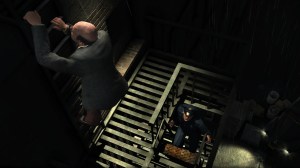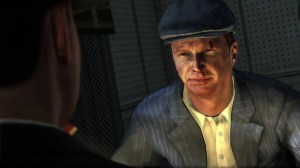This L.A. Noire… something about it rubs me the wrong way. Let’s look at we know so far about the hard-boiled period piece, readers. Aaron Staton–best known as Ken Cosgrove on AMC’s hit drama Mad Men–plays police detective Cole Phelps. Phelps is a WWII vet who last duty in Okinawa, where he earned the Silver Star. Yet there’s something that he feels he needs to atone for.
But, that penny-ante stuff ain’t what’s bothering me. Let’s take a look at that trailer from a few weeks back…
[vodpod id=Video.4888154&w=425&h=350&fv=]
What did we see in that clip? Yeah, there’s a bit of gunplay, but not bullets flying everywhere like you’d see in a Grand Theft Auto trailer or one for Red Dead Redemption. And the trailer goes to great pains to say that it was from made from in-game footage. That probably means there’s not a whole lot of shooting your way through problems in L.A. Noire, right? (More on Time.com: )
In an effort to investigate further, I paid a visit to Rockstar’s New York offices to take a look. The mugs there fired up a PS3 and soon 1940s Los Angeles was coming to life right in front of my very eyes. The first thing you notice is how sharp and realistic the characters look. No occasionally robotic animations here. There’s an uncanny naturalness comes out when they talk to each other. That’s due to an all-new performance capture technology called MotionScan. It’s the brainchild of the Team Bondi development studio in Australia, who also created L.A. Noire.
Here’s how MotionScan works: the actor goes into an all-white room where 32 cameras surround him and record his performance from every angle. Rockstar claims that this process allows them to eliminate the need to facial animators in the development process. The heads and bodies are captured separately, though, and everything from the neck down gets captured by standard motion-capture tech. Over 300 actors were used for L.A. Noire, with many lending their faces and voices to non-playable characters.
 But, enough flappin’ gums about the tech. Let’s move onto the actual gameplay itself. Here’s where I’d get answers. Phelps will work his way through several “desks” in the game, with each representing a particular beat like Traffic, Vice or Homicide. Each desk will have multiple cases. Traffic’s the first desk in the game and I watched as a Rockstar rep played a case called “The Fallen Idol.” It started with a report of a crashed car right across the street from the precinct house. Once Phelps and his partner Bukowski got to the scene, you get the rundown from a uniformed beat cop named Rodriguez. The driver of the car was June Ballard, a faded leading lady who was driving with 15-year-old wannabe movie star Jessica Hamilton. Phelps was then steered to the crime scene, a wrecked Chevy Styleline. You can direct Phelps’ attention to various elements on the scene and in earlier levels, evidence is collected and laid out for you. What we saw were a ripped pair of women’s underwear, a letter from Jessica’s mom begging her to come home and a prop shrunken head from a movie set. Picking up clue objects triggers a lose-up of Phelps’ hand and you can rotate the camera to examine the item more closely. (More on Time.com: Rockstar Games Unveils First Look at L.A. Noire)
But, enough flappin’ gums about the tech. Let’s move onto the actual gameplay itself. Here’s where I’d get answers. Phelps will work his way through several “desks” in the game, with each representing a particular beat like Traffic, Vice or Homicide. Each desk will have multiple cases. Traffic’s the first desk in the game and I watched as a Rockstar rep played a case called “The Fallen Idol.” It started with a report of a crashed car right across the street from the precinct house. Once Phelps and his partner Bukowski got to the scene, you get the rundown from a uniformed beat cop named Rodriguez. The driver of the car was June Ballard, a faded leading lady who was driving with 15-year-old wannabe movie star Jessica Hamilton. Phelps was then steered to the crime scene, a wrecked Chevy Styleline. You can direct Phelps’ attention to various elements on the scene and in earlier levels, evidence is collected and laid out for you. What we saw were a ripped pair of women’s underwear, a letter from Jessica’s mom begging her to come home and a prop shrunken head from a movie set. Picking up clue objects triggers a lose-up of Phelps’ hand and you can rotate the camera to examine the item more closely. (More on Time.com: Rockstar Games Unveils First Look at L.A. Noire)
 All such clues get logged into Phelps’ notebook, along with sketches of the dramatis personae in their neutral states, so that Phelps can question them. They’ll offer up fishy alibis or truthful statements in response and you push back on the person you’re talking in several ways. The options available are: Believe/Coax, Doubt/Force, Disbelieve/Accuse. The main way to know which response you should select is to watch the person you’re talking to. In Ballard’s case, her shifty eyes and twitchy body language prompted the Disbelieve response, which made Phelps go hard at her weak lies.
All such clues get logged into Phelps’ notebook, along with sketches of the dramatis personae in their neutral states, so that Phelps can question them. They’ll offer up fishy alibis or truthful statements in response and you push back on the person you’re talking in several ways. The options available are: Believe/Coax, Doubt/Force, Disbelieve/Accuse. The main way to know which response you should select is to watch the person you’re talking to. In Ballard’s case, her shifty eyes and twitchy body language prompted the Disbelieve response, which made Phelps go hard at her weak lies.

